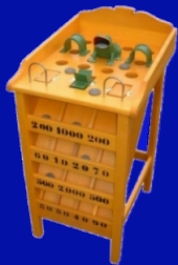Home > Heritage > Traditional games
Traditional games
The traditional games of Picardy, including several sports games, had given rise to competitions between several villages in the region. Board games played in cafes were a way to have fun and get together.
![]()
- Card games
- Skill games
- Sports games
Card games:
The practice of card games developed in the 14th century in Europe, including Spain, Italy, Germany, and several regions of France. The oldest hand-made playing cards were of Chinese origin. After the invention of printed cards, the game spread more widely due to its lower price.
The cards were used for educational purposes in the 18th century under the reign of King Louis XV among the upper class to teach writing and reading to young children. Letters and syllables were stenciled on each side. These cards, being easy to carry, were a distraction for the soldiers, and the favorite games were 'pinochle' and 'piquet' in French.
Belote - pinochle:
A 32-card trick-taking game played in France and Germany with variants. Other versions are known as jass for the Swiss and klaverjas for the Dutch.
Many variations emerged, and the rules evolved several times. It appeared in France in the 1900s. The Pinochle version, played in other countries, has similarities with the French version, but this is not the same.
Brisque:
Two people compete with this 32-card game, once played in cafes by soldiers returning from leave. Almost unknown to younger generations, it tends to disappear.
Manille:
This Spanish-sounding game is played between 2 or 4 players with 32 cards. Other versions are known in France, Spain, Mexico, and Flanders, Belgium.

Piquet:
This 32-card deck dates from the 17th century. The number of participants can vary from two to four. This card game was still popular at the beginning of the 1900s.
Skill-based Games:
The skill games listed below improve dexterity. Some people in convalescence practiced this kind of game.
Game of Frog:
A small piece of furniture made of several scales is essential for play. Each level has several numbered compartments. The goal is to throw a small disk into the rack to obtain the highest number of points. This game was played at village fairs and in the local taverns. It is called the frog game because a cast-iron frog is placed on the upper tray.

Game of frog
Game of Skittles:
The aim is to knock down a maximum number of skittles by throwing a ball or wooden discs. A specific space is needed, either outdoors or indoors. The game of skittles was practiced in European countries and across the globe, with different versions.
The version played in the Somme outdoors, known as the Ponthieu Skittles, is made of nine skittles. The balls are hollowed out for the fingers' positioning.
Game of plates:
This game consists of throwing wooden discs the same width as plates as far as possible from the other end of the board placed on trestles. The difficulty is that the wooden board is narrow, and the thickness of the wooden discs is 3 cm.
Sports games:
The ball with the fist:
The goal is to launch the ball with the fist, protected with a band of fabric or leather. Teams of 5 or 6 people compete on a 65 meters field. To score points, the team must bounce the ball between the posts of the opposing team.
This game, belonging to the category of games called gain ground, was played in the open air. Competitions were organized in the early 1900s and after the war with the neighboring villages. Other localities maintain the practice indoors and outdoors.
Game of "Choule" or "Chole":
The game of Choule was played in Picardy and had an origin dating back to the 12th century in France.
The aim was to touch the ball in the opposing camp with the hands or possibly the feet using a stick. These rules could vary depending on the municipality.
Some versions exist in Scotland under the names Shinty and Hurling for the English and Irish.
Game of "Guise":
The goal was to send the ball as far away as possible to the opposing camp with a bat. It was a widespread sport in Picardy and Flanders, Belgium.
Real tennis:
Real tennis was the starting point of many games, with variations in different forms. This activity, formerly called the king of games and the game of kings, was played in Versailles in a room specially designed for this occasion, the royal tennis court, "la salle du Jeu de Paume" in French. This recently restored space was opened to the public in 2022.
The Count of Artois, the future Charles X, was gifted in this sport, the favorite distraction of great lords. The Chantilly estate in the Oise also had a specially equipped room.
It was the monks who, it seems, invented this game. In the 13th century, they needed to stretch their legs. The players used leather gloves and then wooden beaters, like those used in the past for laundry in the washhouses.
This practice would have been imported into Britain after the Battle of Agincourt, with the French prisoners feeling the need to play sports inside the enclosure. The word "tenez", which means hold in English and is pronounced during the play, has become tennis with a distorted pronunciation in English. The first Wimbledon tournament took place in 1876 and 1928 at Roland Garros.
The Confederation International of the Ball Game, founded in 1928 in Brussels, aims to support ball games derived from real tennis through European or international championships. The head office is in Valencia, Spain.
